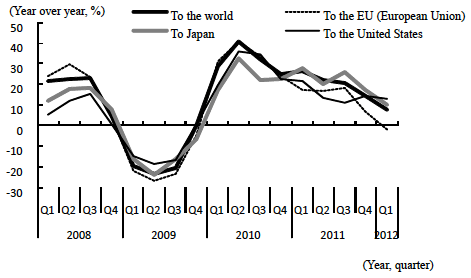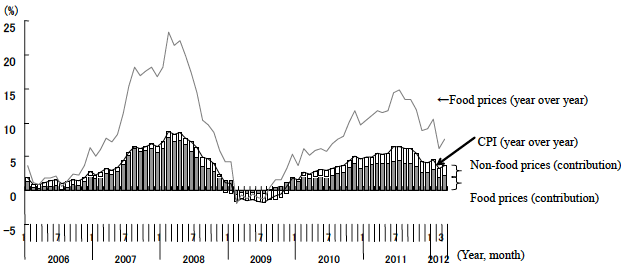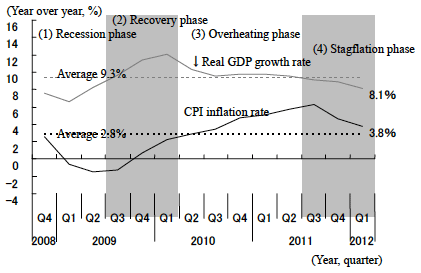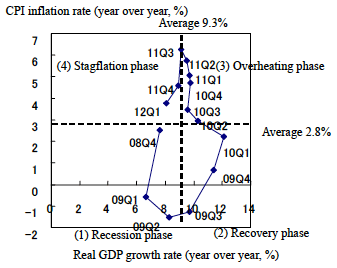In China, inflation is moderating, following a decelerating economy. With this as a backdrop, the authorities' stance on monetary policy is shifting from tightening to easing, as demonstrated by the fact that reserve requirements have been cut twice since December 2011. Since the inflation rate should continue to fall and further monetary easing is expected to be adopted in the months ahead, the Chinese economy is likely to bottom out in the first half of 2012 and recover by the time of the Communist Party Congress, to be held this autumn for the first time in five years.
More room for monetary easing due to decelerating inflation
The growth rate of the Chinese economy decelerated to 8.1% in the first quarter of 2012, the lowest since the first quarter of 2009. Reasons for this include the diminution of the effect of the four trillion yuan stimulus packages that were introduced after the collapse of Lehman Brothers, the prolonged impact of the debt crisis in Europe, and the adoption of monetary tightening to curb inflation. However, growth in overall exports remains relatively high compared to 2009, when the Chinese economy suffered from the Lehman Brothers bankruptcy, although exports to the European Union (EU) have stagnated (Figure 1). Reflecting this, the slowdown in the economy has remained moderate.
Figure 1: Change in China's Exports by Region |
 |
| Note: In U.S. dollar terms |
| Source: Compiled by the author based on data from the CEIC Database. |
Meanwhile, the inflation rate in terms of the year-over-year increase in the consumer price index (CPI) declined to 3.6% in March 2012 from a peak of 6.5% in July 2011. For the following reasons, the inflation rate is likely to fall further. First, since the inflation rate is a lagging indicator of the growth rate, it is expected to fall further going forward, given the recent deceleration in the economy. Also, the year-over-year growth in the M2 money supply fell to 13.4% in March 2012 from 29.7% in November 2009 as monetary tightening proved effective. Moreover, the year-over-year increase in food prices, which had been pushing up the inflation rate, fell to 7.5% in March 2012 from a peak of 14.8% in July 2011 (Figure 2).
Figure 2: Trends in Food Prices that Strongly Affect CPI Inflation |
 |
| Source: Compiled by the author based on data from the National Bureau of Statistics of China. |
The Chinese authorities' stance on monetary policy is shifting from tightening to easing, as reserve requirements have been cut twice by a total of a 1.0 percentage point since December 2011, following a fall in inflation. Room for monetary easing is likely to become even greater going forward.
The economy will improve after going through a recession
Given that the inflation rate is a lagging indicator of the economic growth rate, the economy can be divided into the following four phases, depending on whether growth and inflation rates are higher or lower than their respective reference values: (1) a recession phase, with low growth and low inflation; (2) a recovery phase, with high growth and low inflation; (3) an overheating phase, with high growth and high inflation; and (4) a stagflation phase, with low growth and high inflation (Figure 3).
Figure 3: The Different Stages of the Business Cycle in China after the Lehman Collapse Change in GDP Growth and Inflation Rates |
 |
| Note: Stage (1) is characterized by low growth and low inflation; Stage (2) by high growth and low inflation; Stage (3) by high growth and high inflation; and Stage (4) by low growth and high inflation. |
| Source: Compiled by the author based on data from the CEIC Database. |
If we set the average growth rate (9.3%) and the average inflation rate after the Lehman collapse (2.8%) (the fourth quarter of 2008 through the first quarter of 2012) as the reference values, the Chinese economy has been in (4) a stagflation phase since the third quarter of 2011, after going through (1) a recession phase (the fourth quarter of 2008 through the second quarter of 2009), (2) a recovery phase (the third quarter of 2009 through the first quarter of 2010), and (3) an overheating phase (the second quarter of 2010 through the second quarter of 2011).
This business cycle forms a counterclockwise circle on the plane of coordinates, with the growth rate as the horizontal axis and the inflation rate as the vertical axis, reflecting the fact that the inflation rate follows the growth rate in the same direction with a certain time lag (Figure 4). Looking at the pattern in the past, the circle that illustrates changes in the growth rate and the inflation rate is likely to continue to rotate counterclockwise in the future as well. In other words, the economy will shift from a stagflation phase to a recession phase in the second quarter of 2012, with the inflation rate falling further. At this stage, monetary easing measures will be implemented in earnest, and, in the wake of this, the growth rate will increase as the Communist Party Congress draws near, which will in turn drive the economy into a recovery phase.
Figure 4: Cyclical Changes in GDP Growth and Inflation Rates in China after the Lehman Collapse |
 |
| Note: Stage (1) is characterized by low growth and low inflation; Stage (2) by high growth and low inflation; Stage (3) by high growth and high inflation; and Stage (4) by low growth and high inflation. The business cycle rotates counterclockwise, i.e., (1)→(2)→(3)→(4)→(1). |
| Source: Compiled by the author based on data from the CEIC Database. |


